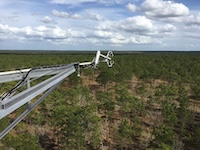Current Research Projects

Seasonality of photosynthesis of temperate and boreal conifer forests across North America
funding: US NSF Macrosystems Biology and NEON-Enabled Science
Our objective is to quantify spatial and temporal variability in forest photosynthetic capacity of conifer forests across North America. This is based on the premise that pigment-based thermal dissipation of excess sunlight is an integrative general property of evergreen plant response to adverse environmental conditions such as winter cold or summer drought. We are examining variation in light energy dissipation mechanisms affecting seasonality of forest photosynthetic capacity across temperate and boreal North America. Temperature, photoperiod, and water stress all influence the magnitude of gross primary production at different times of the year. Their influence is mechanistically controlled by physiological adjustments to photosynthetic capacity to protect plants from excess light under stress via thermal energy dissipation. Associated changes in pigment composition and needle fluorescence emission provide an opportunity to study conifer photosynthesis at the continental scale. We are refining and testing models of forest photosynthetic capacity with data from NEON and other flux tower sites. These tools form the basis for a continental-scale observational framework to quantify photosynthetic response to climate change using recent advances in remote sensing.
selected publications:
Pierrat et al. (2024) The biological basis for using optical signals to track evergreen needleleaf photosynthesis. BioScience, https://doi.org/10.1093/biosci/biad116
Wang et al. (2023) Snow-corrected vegetation indices for improved gross primary productivity assessment in North American evergreen forests, Agricultural and Forest Meteorology, DOI: 10.1016/j.agrformet.2023.109600
Cheng et al. (2022) Evaluating photosynthetic activity across Arctic-Boreal land cover types using solar-induced fluorescence, Environmental Research Letters, https://doi.org/10.1088/1748-9326/ac9dae
Pierrat et al. (2022) Forests for forests: combining vegetation indices with solar-induced chlorophyll fluorescence in random forest models improves gross primary productivity prediction in the boreal forest, Environmental Research Letters, https://doi.org/10.1088/1748-9326/aca5a0
Yang et al. (2022) Gross primary production (GPP) and red solar induced fluorescence (SIF) respond differently to light and seasonal environmental conditions in a subalpine conifer forest, Agricultural and Forest Meteorology, 317, 10.1016/j.agrformet.2022.108904

Consequences of seasonal snow cover for carbon cycling of world forests: direct and legacy effects
funding: US NSF Division of Environmental Biology
We are investigating the roles of snow-mediated biophysical effects and related cross-season legacy effects on carbon cycling in seasonally snow-covered forests of the northern hemisphere. A snowpack provides a strong energy decoupling between the soil and the air, markedly changing the light, temperature and moisture environment underneath the snow. The snowpack provides moisture into the summer growing season in many regions, a moisture legacy across seasons. Warming climate is influencing plant phenological processes worldwide, with unknown effects on photosynthesis and respiration of terrestrial ecosystems.
selected publications:
Yang et al. (2024) Forest carbon uptake as influenced by snowpack and length of photosynthesis season in seasonally snow-covered forests of North America, Agricultural and Forest Meteorology, 353, 110054, https://doi.org/10.1016/j.agrformet.2024.110054
Bowling et al. (2024) Phenology of photosynthesis in winter-dormant temperate and boreal forests: Long-term observations from flux towers and quantitative evaluation of phenology models, JGR-Biogeosciences, 129, e2023JG007839, https://doi.org/10.1029/2023JG007839

Carbon Monitoring System in Mountains (CMS-Mountains): Leveraging Satellite-based Solar Induced Fluorescence to Understand Forest Drought and Mortality in the Western U.S.
funding: NASA Carbon Monitoring Systems, collaborative with Prof. John Lin, U. Utah Atmospheric Sciences
Despite the need to understand terrestrial carbon fluxes to account for carbon cycle feedbacks and predict future carbon dioxide levels, knowledge of these fluxes at the regional scale remains poor. This is particularly true in mountainous areas, where complex terrain, associated microclimate and relative lack of observations lead to significant uncertainties in carbon fluxes. Yet mountainous regions are also where significant forest cover and biomass are found. In this project we are 1) Studying gross primary production in complex terrain using high resolution satellite solar-induced fluorescence (SIF) and MODIS reflectance data, combined with flux tower data, 2) Using satellite data to improve photosynthetic phenology and regional carbon stocks/fluxes within the Community Land Model, and 3) working with stakeholders to develop an early warning system for forest mortality.
selected publications:
Kunik L, Bowling DR, Raczka B, Frankenberg C, Kohler P, Cheng R, Smith KR, Goulden M, Jung M, Lin JC (2024) Satellite-based solar-induced fluorescence tracks seasonal and elevational patterns of photosynthesis in California’s Sierra Nevada mountains, Environmental Research Letters, DOI 10.1088/1748-9326/ad07b4
Duarte et al. (2022) How can biosphere models grow enough vegetation biomass in the mountains of the western United States? Implications of meteorological forcing, Environmental Modeling and Software, 10.1016/j.envsoft.2021.105288
Raczka BM, Hoar TJ, Duarte HF, Fox AM, Anderson JL, Bowling DR, Lin JC (2021) Improving CLM5.0 biomass and carbon exchange across the western United States using a data assimilation system, J. Advances in Modeling Earth Systems, DOI:10.1029/2020MS002421
